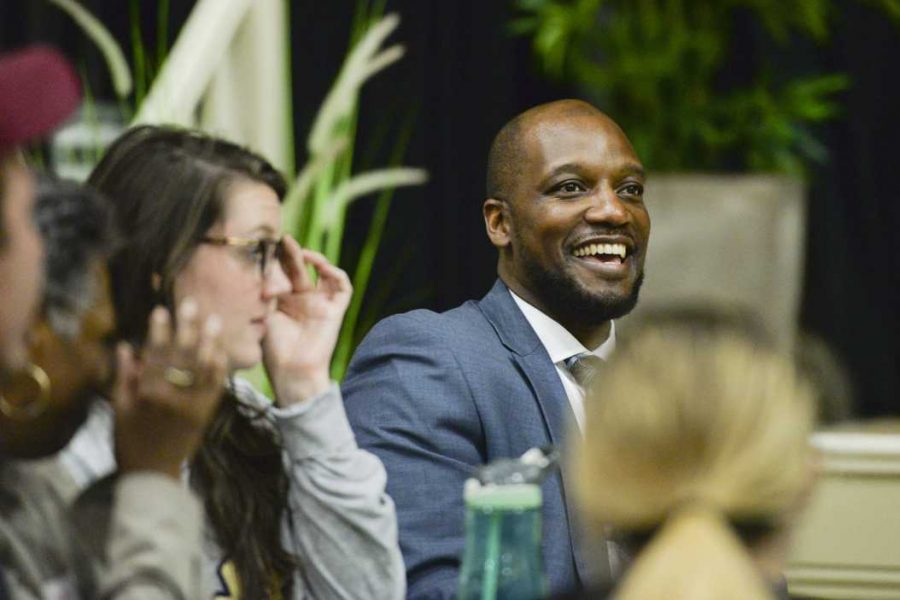When Kenyon Bonner took the stage in front of a crowd of students Tuesday night, he invited them to talk over him.
As students took turns passing around a microphone and sharing their opinions, Bonner, Pitt’s vice provost and dean of students, gripped the edge of the podium in the center of the O’Hara Student Ballroom’s stage. With a pen threaded between his fingers, Bonner gazed out into the middle of the room at the student speakers, taking short pauses to scribble on a piece of paper in front of him.
Tuesday night, those in attendance at the event, called “Dialogue with the Dean” were not focused on the dean but rather on the student voices that filled the ballroom.
The idea sharing was part of a University-sponsored conversation about diversity and inclusion — and how Pitt could improve in both areas. The event was held as part of the Year of Diversity and allowed students to share their perspectives on the University’s attempt to improve diversity and inclusion on campus, which Bonner said meant representing the entire spectrum of humanity on campus and making everyone feel like they belong.
The discussion was open to all Pitt students. According to organizers, 150 undergraduate and graduate students RSVP’d to the event.
“The spirit of this event is really a genuine interest in hearing from you students,” Bonner said. “In order to get where we need to be, we all need to be involved.”
Organizers working with the Year of Diversity and Inclusion divided the students into round tables of six to 10 students, each featuring a faculty facilitator who posed questions such as, “How is the climate at Pitt around diversity and inclusion?” and, “What is Pitt doing well, and what could be improved?”
Students discussed a need for greater visibility and publicity of events centered around diversity and events offered by cross-cultural student groups in addition to greater collaboration and communication between diverse student organizations such as Black Action Society and Campus Women’s Organization.
One student suggested Pitt should hold a “president’s council” once a month where representatives from all campus student groups could meet to discuss what events they were holding for the month.
Additionally, students emphasized that diversity involves not only race but also gender, sexual orientation, socioeconomic diversity and cognitive disorders, such as ADD. They said that all aspects of diversity should be addressed.
For Solangel Garcia, a junior accounting major, the need for increased socioeconomic diversity at Pitt is personal. She thinks recruiting students of lower socioeconomic status would help to increase other types of diversity — such as racial and ethnic diversity — as well, exposing students to a variety of perspectives.
Garcia moved to Pittsburgh from the Dominican Republic in 2009. After attending community college in New Jersey for two years, she returned to Pennsylvania to enroll at Pitt. Now a junior at Pitt, she said she has struggled to pay for her education at Pitt.
Based on her own experience, Garcia suggested that Pitt offer more financial aid opportunities than it currently does.
For full-time, in-state students, Pitt’s tuition ranges from about $17,000 to about $22,000, depending on the college they are a part of. For out-of-state students, the price ranges from $28,000 to $33,000, according to the Office of Admissions and Financial Aid website.
Although she said she loves being a student at Pitt, Garcia said had she known how hard it would be to pay for school, she probably would not have ever applied to the University.
“If [Pitt] is looking for diversity and inclusion, it’s not only about race or ethnicity,” Garcia said. “I’m pretty sure there are many, many smart people, [but] they give up before they even begin because they don’t know how they’re going to be able to finance school.”
For Stanley Umeweni, a sophomore mechanical engineering major, the number of students of different races or ethnicities should not be Pitt’s only concern. He said the integration of diverse people, experiences and perspectives is more important than just the numbers.
“It’s about mixing,” Umeweni said. “Diversity is all about sharing experiences.”
Sharing experiences and perspectives through interaction with students outside of one’s comfort zone was a recurring theme. One student talked about how it can be important to look at diversity, or lack thereof, not just through a minority lens but through a white lens as well.
“How unfortunate it is that you came to college for four plus years, and you only saw people just like you. You could’ve just stayed at home,” one student said.
Throughout the discussion, many students raised concerns about how long Pitt’s focus on diversity would last. Most said it would take more than one year to effectively address diversity and all its encompassing issues.
“We just want to know what happens when the Year of Diversity is over?” one student said. “Like, then what?”
Bonner, who spent most of the meeting silently listening, said the end of the year would not mark the end of Pitt’s commitment to diversity.
Instead, he said, this year is meant to be a spark that will raise attention to diversity and inclusion. In the long term, Bonner said that Pitt could look at campus climate, retention of students, faculty and staff recruitment and retention, programming and what students are learning to monitor Pitt’s progress.
“Is this a one-and-done?” Bonner said. “Absolutely not.”


